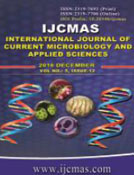


 National Academy of Agricultural Sciences (NAAS)
National Academy of Agricultural Sciences (NAAS)

|
PRINT ISSN : 2319-7692
Online ISSN : 2319-7706 Issues : 12 per year Publisher : Excellent Publishers Email : editorijcmas@gmail.com / submit@ijcmas.com Editor-in-chief: Dr.M.Prakash Index Copernicus ICV 2018: 95.39 NAAS RATING 2020: 5.38 |
Biofilm production in bacterial pathogens is a serious threat to medical management of infections. Owing to decreased penetration through biofilm matrix, most antibiotics fail to effectively eliminate these bacterial strains which continue to persist and result in emergence of drug resistance in healthcare setups. Therefore, a bioactive substance with biofilm inhibitory action is more likely to enhance the antimicrobial effect of antibiotic therapy. To investigate the anti-biofilm action of curcumin in bacterial pathogens. Biofilm producing bacterial strains isolated from various samples were identified by Congo red agar method. These isolates were inoculated on Congo red agar with increasing concentrations of curcumin (2, 4, 8, 1 6, 32, 64, 128, 256 and 512 µg/ml) to detect the inhibition of biofilm formation at its various concentration. Biofilm production was detected among 60 isolates i.e. Escherichia coli (n=23, 38.3%), Klebsiella pneumoniae (n=13, 21.6%), Staphylococcus aureus (n=13, 21.6%), Citrobacter freundii (n=6, 10%), Pseudomonas aeruginosa (n=3, 5%) and Enterococcus faecalis (n=2, 3.3%) by Congo red agar. Majority (53.3%) were from urine samples, followed by pus, sputum, aspirate and endotracheal secretion. These isolates showed minimum biofilm inhibitory concentration (MBIC) ranging from 4 to 128 µg/ml. Among gram negative bacteria, higher MBIC was found among E. coli (79.3% isolates with MBIC 128 µg/ml) and among gram positive bacteria 84.6% S. aureus isolates had MBIC of 32 µg/ml. Curcumin was found to be a potent bioactive substance which inhibits biofilm formation in gram positive and gram negative bacterial clinical isolates. It may have promising role in treatment of infections with biofilm forming bacteria in combination therapy with antibiotics.
 |
 |
 |
 |
 |